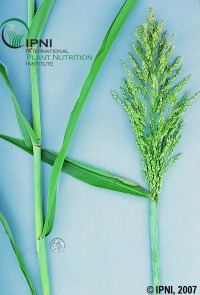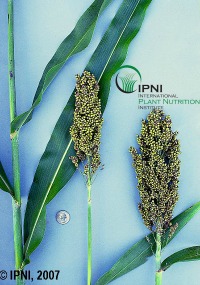Sorghums
Overview
Members of the Sorghum family are often used for forage in Georgia. These warm season grasses are also of African origin. These grasses may contain toxic levels of nitrates and prussic acid under stress conditions (drought, frost/freeze, etc.). As such, they are not preferred choices for grazing or hay production (unless irrigated). Sorghums are generally more difficult to cure for hay than pearl millet or other summer annual forage crops. Therefore, they are best adapted to use as a silage crop. The ensiling process results in the dissipation or breakdown of prussic acid and high nitrate levels after 2 – 3 weeks, reducing the toxicity problem for livestock.
In addition to the potential for prussic acid toxicity, some have reported the presence of an unidentified toxin in sorghum, particularly in sorghum x sudangrass hybrids. This toxin or factor appears to cause spinal cord degeneration and, in extreme cases, paralysis in horses (sorghum cystitis ataxia syndrome). The potential for this problem and the lack of an effective treatment or cure for this syndrome has led to a general recommendation that horses should NOT be fed forage from the sorghum family.
Sorghum x Sudangrass Hybrids
Adaptation
- Warm climates of the southeastern U.S.
- Best on well drained, fertile soils.
- Drought tolerant.
Establishment
Seed in April (i.e., whenever soil temperatures at 2” depth reach 65o F) - June. See Establishment of Warm Season Annual Grasses for more details.
 Hybrids of forage sorghum and sudangrass are commonly grown as a warm season annual crop in Georgia. These hybrids have the highest yield potential of any of the summer annuals, if adequate rainfall is received or irrigation is provided. However, sorghum x sudan yields are more severely affected by drought than pearl millet, are less tolerant of poor soil conditions and soil pH values less than 5.8. Sorghum x sudans can be used for grazing or silage, but like other annual sorghums, their forage is very difficult to dry to moistures suitable for hay production. If grazed, the sorghum x sudan hybrids should be rotationally grazed allowing the forage to reach 24 inches before grazing (i.e., managed like sudangrass). At this stage, sorghum x sudans will generally have TDN values in excess of 53 - 60% and CP concentrations of 9 - 15%. Brown midrib (BMR) varieties are usually preferred varieties for grazing since they have less lignin and higher digestibility than other varieties. Research in Texas has indicated that BMR varieties may improve animal gains by as much as 5 – 8% relative to non-BMR varieties.
Hybrids of forage sorghum and sudangrass are commonly grown as a warm season annual crop in Georgia. These hybrids have the highest yield potential of any of the summer annuals, if adequate rainfall is received or irrigation is provided. However, sorghum x sudan yields are more severely affected by drought than pearl millet, are less tolerant of poor soil conditions and soil pH values less than 5.8. Sorghum x sudans can be used for grazing or silage, but like other annual sorghums, their forage is very difficult to dry to moistures suitable for hay production. If grazed, the sorghum x sudan hybrids should be rotationally grazed allowing the forage to reach 24 inches before grazing (i.e., managed like sudangrass). At this stage, sorghum x sudans will generally have TDN values in excess of 53 - 60% and CP concentrations of 9 - 15%. Brown midrib (BMR) varieties are usually preferred varieties for grazing since they have less lignin and higher digestibility than other varieties. Research in Texas has indicated that BMR varieties may improve animal gains by as much as 5 – 8% relative to non-BMR varieties.
Variety comparison among noteworthy sorghum x sudangrass hybrids.a
| Varietya | Regionb | Yieldsc | SCA Toleranced | Company | Commentse |
| AS5201 | S | good | poor | Alta Seeds | 3 |
| AS6401 | P | good | poor | Alta Seeds | 3 |
| AS6402 | P | good | poor | Alta Seeds | 3 |
| DSM 33-948 | CP | good | good | Desert Sun | 2 |
| FullGraze BMR | CP | good | good | Dyna-Gro | 1 |
| SDH 2942BMR | P | good | poor | Sorghum Partners | 3 |
| Southern Star | CP | good | v. good | Meherrin Ag | 1 |
| SOUTHERN SWEET | CP | fair | good | Meherrin Ag | 2 |
| SP6205 BD | CP | good | good | Sorghum Partners | 2 |
| SS-220BMR | S | good | poor | Southern States | 3 |
| Super Sugar | S | good | good | Gayland Ward | 3 |
| Sweet Six BMR Dry Stalk | S | good | poor | Gayland Ward | 3 |
| XtraGraze BMR | P | good | good | Coffey | 3 |
- a Bolded varieties meet the yield performance criteria yields greater than average for 3 yrs in the Statewide Variety Testing program) to be recommended by UGA and have at least a good tolerance to the sugarcane aphid (SCA).
- b Region where recommended where P = Piedmont and Mountains, CP = Coastal Plain, and S = Statewide.
- c Yield ratings where good = average or above, fair = below average. Poor yielding varieties are not listed.
- d Ratings for resistance to sugarcane aphid damage where poor = no resistance, good = moderate resistance, very good = resistant, and excellent = highly resistant.
- e Number of years the variety was included in the Statewide Variety Testing program’s summer annual forage trial. 1 = 1 year; 2 = 2 years; and 3 = 3 or more years. More info on UGA's Statewide Variety Testing page
Forage Sorghums
Adaptation
- Warm climates of the southeastern U.S.
- Best on well drained, fertile soils.
- Drought tolerant.
Establishment
Seed should be drilled 1 – 1 ½ inches deep at 15 - 20 lb/A or broadcast at 25 - 30 lb/A in April (i.e., whenever soil temperatures at 2” depth reach 65o F) - June.
 Forage sorghums are high yield producers that may have from 0 – 50% grain in the forage, depending upon the hybrid and stage of maturity at harvest. As plants mature, lignification increases sharply, reducing digestibility and quality. BMR hybrids can improve digestibility, but this trait has increased lodging in some varieties. Careful selection of BMR hybrids and timing of harvest are necessary to get highest total digestible nutrients (TDN). Highest crude protein and digestibility will usually be obtained by harvesting in the vegetative growth stage while dry matter production will be increased from more mature plants. Harvesting in the late grain dough stage will result in a lower average TDN value, but will maximize the amount of TDN harvested per acre.
Forage sorghums are high yield producers that may have from 0 – 50% grain in the forage, depending upon the hybrid and stage of maturity at harvest. As plants mature, lignification increases sharply, reducing digestibility and quality. BMR hybrids can improve digestibility, but this trait has increased lodging in some varieties. Careful selection of BMR hybrids and timing of harvest are necessary to get highest total digestible nutrients (TDN). Highest crude protein and digestibility will usually be obtained by harvesting in the vegetative growth stage while dry matter production will be increased from more mature plants. Harvesting in the late grain dough stage will result in a lower average TDN value, but will maximize the amount of TDN harvested per acre.
Grain sorghums, as the name suggests, are prolific grain producers and best used for that purpose. Grain sorghums are dwarfed cultivars of the same species as forage sorghums. Though they may also produce substantial forage yields, the quality of the forage from grain sorghum varieties is generally much lower than forage sorghums.
Variety comparison among noteworthy forage sorghum varieties.a
| Variety | Regionb | Yieldsc | SCA Toleranced | Company | Commentse |
| 4Ever Green | S | good | poor | Moss | 3 |
| AF7401 | S | fair | poor | Alta Seeds | 3 |
| F73FS10 | S | good | fair | Dyna-Gro | 1 |
| F74FS23 BMR | S | good | fair | Dyna-Gro | 1 |
| F76FS77 | P | good | fair | Dyna-Gro | 1 |
| NK300 | CP | good | fair | Sorghum Partners | 3 |
| SP 2880 | CP | fair | fair | Sorghum Partners | 1 |
| SP2774 BMR | CP | good | fair | Sorghum Partners | 2 |
| SP2876 BMR | CP | good | fair | Sorghum Partners | 2 |
- a Bolded varieties meet the yield performance criteria yields greater than average for 3 yrs in the Statewide Variety Testing program) to be recommended by UGA and have at least a good tolerance to the sugarcane aphid (SCA).
- b Region where recommended where P = Piedmont and Mountains, CP = Coastal Plain, and S = Statewide.
- c Yield ratings where good = average or above, fair = below average. Poor yielding varieties are not listed.
- d Ratings for resistance to sugarcane aphid damage where poor = no resistance, good = moderate resistance, very good = resistant, and excellent = highly resistant.
- e Number of years the variety was included in the Statewide Variety Testing program’s summer annual forage trial. 1 = 1 year; 2 = 2 years; and 3 = 3 or more years.
Sudangrass
Adaptation
- Warm climates of the southeastern U.S.
- Best on well drained, sandy soils.
- Moderate drought tolerance.
Establishment
Seed should be drilled 1 – 1 ½ inches deep at 10 - 15 lb/A or broadcast at 20 - 25 lb/A in April (i.e., whenever soil temperatures at 2” depth reach 65o F) - June.
Varieties
AS9301, Sudan Headless, Trudan Headless
More info on UGA's Statewide Variety Testing page.
 Sudangrass has finer stems, tillers more profusely, and is leafier than forage sorghums. They produce very few seed. Their rate of regrowth after cutting or grazing is superior to that of sorghums. For this reason, they are sometimes used for temporary rotational grazing. However, sudangrass usually produces lower yields than pearl millet or the sorghum x sudan hybrids and requires fertile soils with a pH of 5.8 or higher. Sudangrass tends to have less prussic acid accumulation than forage sorghums, and the levels decrease with maturity. For this reason, care should be taken to let sudangrass accumulate to at least 24 inches of regrowth before grazing.
Sudangrass has finer stems, tillers more profusely, and is leafier than forage sorghums. They produce very few seed. Their rate of regrowth after cutting or grazing is superior to that of sorghums. For this reason, they are sometimes used for temporary rotational grazing. However, sudangrass usually produces lower yields than pearl millet or the sorghum x sudan hybrids and requires fertile soils with a pH of 5.8 or higher. Sudangrass tends to have less prussic acid accumulation than forage sorghums, and the levels decrease with maturity. For this reason, care should be taken to let sudangrass accumulate to at least 24 inches of regrowth before grazing.
Dr. Dennis Hancock
Forage Extension Specialist
Crop & Soil Sciences Dept.
